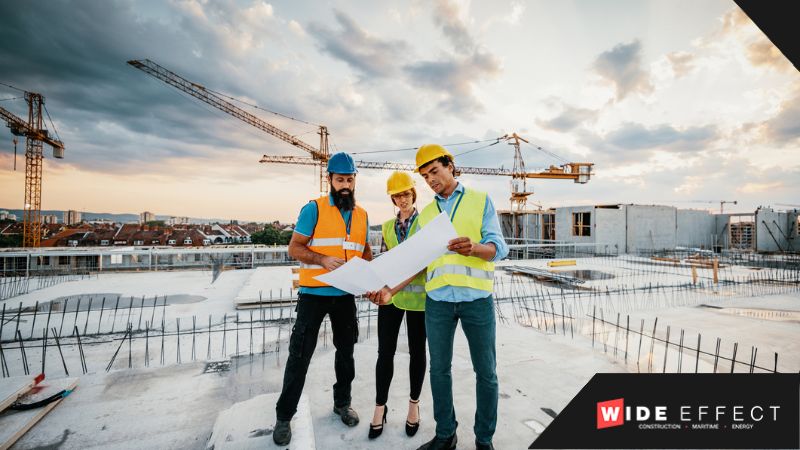
The industrial construction industry is undergoing a pivotal transformation, led by several innovative technologies and methodologies. Wearable devices, from smart helmets to sensor-laden vests, are prioritizing worker safety by monitoring health metrics and potential site hazards. Building Information Modeling (BIM) replaces traditional sketches with dynamic 3D models, streamlining design and collaboration. A renewed focus on sustainability has ushered in eco-friendly materials and techniques like modular construction, emphasizing reduced waste and emissions. Lastly, the advent of autonomous machinery, including drones and robotic arms, is enhancing efficiency and precision in construction tasks. Collectively, these innovations underscore a future where empathy and technology converge, championing safety, sustainability, and efficiency.
The construction industry, once viewed as a sector resistant to change, is undergoing a transformative era of innovation. This metamorphosis isn't just about building higher or designing bolder; it's about how technology and new methodologies are redefining the very foundation of industrial construction. Today, let’s embark on an exploration of the innovations that are not just reshaping, but revolutionizing this age-old industry.
The safety of workers is paramount in any industry, but in construction, the stakes are even higher. The advent of wearable technology has been a game-changer in ensuring the safety of those on the construction site. Devices, from smart helmets with built-in cameras to vests with biometric sensors, monitor workers' vitals, fatigue levels, and overall health. These wearables can predict and prevent potential accidents by alerting supervisors to hazards or notifying them if a worker is in distress, ensuring immediate action and minimizing risks.
The era of sketches and 2D plans seems almost archaic with the introduction of Building Information Modeling. BIM is a dynamic 3D model-based process that gives construction professionals the tools to design, plan, and manage buildings more efficiently. Beyond its visually appealing 3D renderings, BIM aids in accurate estimations, detecting any design conflicts, and providing a comprehensive view of the project from inception to completion. By enhancing collaboration and precision, BIM has paved the way for more informed decisions, reduced wastage, and streamlined operations.
Sustainability is not just a buzzword; it’s the need of the hour. The industrial construction sector, historically notorious for its high carbon footprint, is now at the forefront of the green evolution. Innovations such as eco-friendly construction materials, solar tiles, and energy-efficient designs are making buildings more sustainable. Additionally, techniques like modular construction, where parts of buildings are prefabricated in factories and then assembled onsite, have reduced on-site waste and emissions. Through these advancements, the industry is proving that it’s entirely possible to build for the future while being kind to our planet.
Automation has made its mark in various industries, and construction is no exception. The introduction of autonomous or semi-autonomous machines is reimagining labor-intensive tasks. Drones are being used for site surveys, offering a bird's eye view, and tracking progress, while robotic arms and machinery are taking over jobs like bricklaying and concrete dispensing. These machines not only increase efficiency but also reduce human errors and the risks associated with physically demanding tasks.
As we stand at the precipice of this transformation, it’s essential to acknowledge the driving forces behind these innovations. It’s a blend of necessity, the passion of brilliant minds, and the undeniable evolution of technology. Moreover, the underlying current in all these advancements is empathy. The focus on worker safety, the push towards sustainability, and the move to make tasks easier with automation—all these innovations stem from a place of understanding and compassion for both the people in the industry and the world at large.
In conclusion, the realm of industrial construction is expanding beyond brick and mortar. It's embracing a future where technology melds seamlessly with human skills, where safety is not just a guideline but a tech-integrated mandate, and where buildings rise with a conscience towards the environment. These innovations are not merely reshaping industrial construction; they're setting a precedent for industries. As we build upwards, we're also building forward, steering the industry into an era of intelligence, empathy, and sustainability.
Written on behalf of Wide Effect.
Are you experiencing productivity challenges, skill gaps in your workforce, or do you need a short-term placement? Don't waste your time and money navigating these alone. We bring the process, experience, and placement successes you need to make your labor force concerns a thing of the past. Call us at 1 (833) 493-5627 or use the contact form to discuss your personalized staffing solution.
By submitting this form, you opt-in and give expressed consent to receiving SMS / text messages, calls, and emails from us for the purposes of communication related to your inquiry or related to the products and or services we provide.